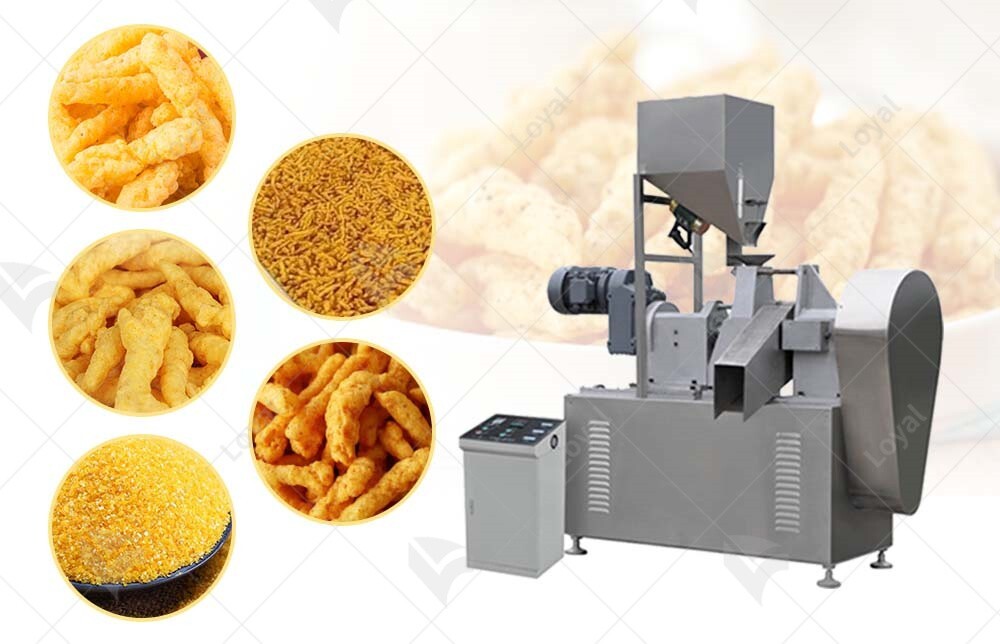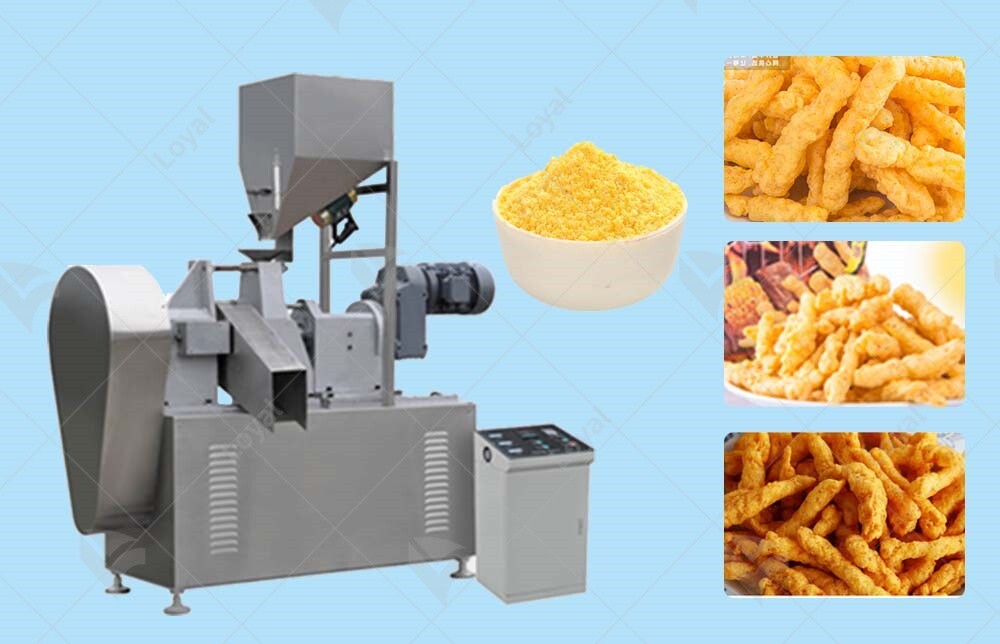Everything You Need To Know Aboutcorn extruder
A brief overview of corn extrusion technology
Corn extrusion technology is a critical process in the food industry, particularly for the production of various food products from corn. This technology involves forcing a heated and hydrated mixture of corn through a die with a specific shape and size, resulting in a continuous extrudate with a desired shape, texture, and nutritional profile.
The history of corn extrusion dates back to the early 20th century, when the first extruders were developed to process cereals and grains. Over time, the technology has evolved significantly, with advancements in machinery design, automation, and control systems. Today, corn extruders are highly sophisticated pieces of equipment that can produce a wide range of food products, including snacks, breakfast cereals, pet foods, and even bio-plastics.
The basic principle of corn extrusion involves the use of a screw conveyor, or auger, that pushes the corn mixture through the die. The temperature, pressure, and shear forces applied during the extrusion process alter the physical and chemical properties of the corn, resulting in a product with unique textural and nutritional characteristics. For instance, extrusion can increase the bulk density and stability of the product, improve its digestibility, and reduce the cooking time.
In addition to its versatility in product creation, corn extrusion technology offers several other benefits. It is a highly efficient process that can produce large quantities of food products in a short period of time. Moreover, it allows for precise control over the product's shape, size, and texture, enabling manufacturers to meet specific consumer preferences and market demands.
As the food industry continues to evolve, so too does the technology behind corn extrusion. Manufacturers are constantly seeking ways to improve the efficiency and product quality of their extrusion processes. This has led to the development of advanced corn extruders that incorporate cutting-edge technology, such as automated control systems, precision temperature and pressure regulation, and energy-efficient designs.
In conclusion, corn extrusion technology is a fundamental process in the food industry, with a rich history and a promising future. With continuous advancements in machinery design and automation, the technology is poised to play an even greater role in the production of high-quality food products from corn.

An in-depth look at current corn extruder designs and features
In the evolving landscape of food machinery, the corn extruder has become a cornerstone of modern food production. This versatile piece of equipment has undergone numerous innovations, resulting in designs and features that significantly enhance efficiency and product quality.
Advanced Screw Designs | One of the most significant advancements in corn extruder design is the development of advanced screw configurations. The screw, or auger, is the heart of the extruder, responsible for conveying the corn material through the machine and applying the necessary pressure and shear forces to shape and texture the product. Modern corn extruders often feature multi-stage screws with varying pitch and diameter. This design allows for more precise control over the extrusion process, enabling manufacturers to achieve specific textures and flavors. Additionally, some screws are equipped with mixing elements that enhance the homogeneity of the corn material, ensuring consistent product quality. |
Precision Die Plates | Another key feature of modern corn extruders is the use of precision die plates. The die plate is the final stage of the extrusion process, where the corn material is shaped into the desired form. Advances in machining technology have allowed for the creation of die plates with intricate patterns and precise dimensions. These precision die plates enable manufacturers to produce a wide range of product shapes and sizes, from simple rods and flakes to complex three-dimensional structures. The ability to customize die plates also allows for greater flexibility in product development, enabling manufacturers to quickly adapt to market trends and consumer preferences. |
High-Efficiency Heating and Cooling Systems | Temperature control is crucial in the extrusion process, as it affects the physical and chemical properties of the corn material. Modern corn extruders are equipped with high-efficiency heating and cooling systems that allow for precise temperature regulation throughout the process. These systems often utilize advanced heating elements, such as induction heaters, which provide rapid and uniform heating. Additionally, cooling systems, such as water jackets or air-cooled exchangers, are used to quickly remove heat from the extruder, preventing material degradation and ensuring product quality. |
Automated Control Systems | Automation has played a significant role in the evolution of corn extrusion technology. Modern corn extruders are often equipped with automated control systems that monitor and adjust the extrusion process in real-time. These systems utilize sensors and actuators to monitor critical process parameters, such as temperature, pressure, and screw speed. By continuously analyzing this data, the control system can make adjustments to ensure optimal process conditions. This automation not only enhances efficiency but also improves product consistency and reduces waste. |
Material Handling and Feeding Systems | Finally, modern corn extruders are designed with advanced material handling and feeding systems that streamline the production process. These systems often include vibratory feeders, screw conveyors, and other equipment that ensure a consistent and reliable feed of corn material into the extruder. By optimizing material handling, manufacturers can reduce downtime and increase production capacity. Additionally, these systems often incorporate safety features, such as emergency stops and interlocks, to ensure the safe and efficient operation of the extruder. |

The role of automation and technology in improving extrusion processes
The role of automation and technology in improving extrusion processes is significant and multifaceted. Extrusion processes, widely used in the food, plastic, and other industries, involve shaping material by forcing it through a die under pressure. Automation and technology have greatly enhanced these processes, leading to increased efficiency, improved product quality, and cost savings.
Increased Efficiency
Automated Feeding and Control Systems | Automated feeding systems ensure that the extruder receives a consistent and controlled flow of raw materials.Control systems, such as PLCs (Programmable Logic Controllers) and SCADA (Supervisory Control And Data Acquisition) systems, monitor and regulate process variables like temperature, pressure, and screw speed, optimizing the extrusion process for maximum efficiency. |
Real-Time Monitoring and Diagnostics | Sensors and data acquisition systems provide real-time feedback on the extrusion process.Machine learning algorithms can analyze this data to predict potential issues and optimize process parameters, reducing downtime and maintenance costs. |
Improved Product Quality
Precision Control | Automation allows for precise control of the extrusion process, ensuring consistent product quality.Variables such as temperature, pressure, and screw speed can be tightly regulated, leading to more uniform product characteristics. |
Reduced Waste | Automated systems minimize material waste by ensuring accurate feeding and control of the extrusion process.Scrap rates are reduced, and material usage is optimized, leading to cost savings and improved sustainability. |
Enhanced Product Design | CAD (Computer-Aided Design) and simulation software enable engineers to design and test new product shapes and sizes before physical production.This reduces the need for costly and time-consuming prototype testing, speeding up product development cycles. |
Cost Savings
Labor Reduction | Automated systems reduce the need for manual labor, lowering labor costs.Operators can monitor multiple machines simultaneously, increasing productivity. |
Energy Efficiency | Advanced control systems optimize energy usage, reducing electricity consumption.Variable frequency drives (VFDs) on motors can adjust power output to match the load, further reducing energy waste. |
Maintenance and Upkeep | Predictive maintenance, enabled by real-time monitoring and diagnostics, reduces unexpected downtime and extends equipment lifespan.Regular maintenance schedules can be optimized based on usage data, minimizing unnecessary repairs and replacements. |

Innovations in Corn Extrusion
Innovations in corn extrusion have significantly transformed the food processing industry, leading to improved product quality, increased efficiency, and reduced environmental impact. Here are some key innovations in corn extrusion:
1. Advanced Extrusion Machinery and Technology
High-Precision Extruders: Modern corn extruders are equipped with advanced sensors and control systems that enable precise temperature and pressure control during the extrusion process. This results in more consistent product quality and reduced waste.
Multi-Stage Extrusion: Multi-stage extrusion technology allows for more complex processing steps, enabling the production of a wider range of products with different textures, shapes, and nutritional profiles.
2. Sustainable and Eco-Friendly Practices
Energy-Efficient Machinery: Manufacturers have developed energy-efficient extruders that consume less power and produce less waste heat. This reduces operational costs and environmental impact.
Biodegradable and Sustainable Raw Materials: The use of biodegradable and sustainable raw materials in corn extrusion is becoming more common. This aligns with global efforts to reduce plastic waste and promote circular economy principles.
3. Nutritional Enhancement and Functionalization
Fortification with Micronutrients: Corn extrusion technology can be used to fortify products with essential micronutrients such as vitamins, minerals, and fiber. This enhances the nutritional value of the final product.
Functional Ingredients: The incorporation of functional ingredients, such as probiotics, prebiotics, and antioxidants, during the extrusion process allows for the production of products with additional health benefits.
4. Process Optimization and Automation
Real-Time Monitoring and Control: Advanced sensors and control systems enable real-time monitoring of the extrusion process. This allows for immediate adjustments to ensure optimal product quality and reduce defects.
Automation and Robotics: The integration of automation and robotics in corn extrusion processes has increased productivity and reduced labor costs. Robotic arms and conveyors handle raw materials, feed the extruder, and package the final product with minimal human intervention.
5. Novel Product Development
Innovative Textures and Shapes: Corn extrusion technology can be used to create a wide range of textures and shapes, enabling the development of novel products that cater to consumer preferences.
Customized Nutrition Solutions: With the increasing demand for personalized nutrition, corn extrusion technology can be used to produce customized products that meet specific dietary needs and preferences.
6. Research and Development
Ongoing Research: Continuous research and development efforts are focused on improving the efficiency, sustainability, and nutritional profile of corn extrusion processes.
Collaborations with Universities and Research Institutions: Manufacturers often collaborate with universities and research institutions to stay at the forefront of technological advancements and develop innovative solutions.
In conclusion, innovations in corn extrusion have significantly improved product quality, increased efficiency, and reduced environmental impact. These advancements have enabled the food processing industry to meet the growing demand for nutritious, convenient, and sustainable food products. As technology continues to evolve, we can expect even more exciting developments in the field of corn extrusion.

The Current Challenges Facing the Corn Extrusion Industry
In the dynamic world of food processing, the corn extrusion industry faces a multitude of challenges that necessitate continuous innovation and technological advancements.I have observed several pressing issues that the industry must address to ensure sustained growth and competitiveness.
1. Energy Efficiency and Environmental Impact
One of the foremost challenges facing the corn extrusion industry is the need to improve energy efficiency and reduce environmental impact. Traditional corn extruders consume significant amounts of energy, leading to high operational costs and a considerable carbon footprint. The industry must invest in energy-efficient machinery and explore sustainable raw materials to mitigate these concerns.
To address this, manufacturers are increasingly adopting advanced corn extruders equipped with energy-saving features such as optimized heating and cooling systems, and waste heat recovery mechanisms. Additionally, the integration of renewable energy sources, such as solar and wind power, can further reduce the environmental footprint of corn extrusion processes.
2. Product Quality and Consistency
Ensuring consistent product quality is another significant challenge for the corn extrusion industry. Variability in raw material quality, processing conditions, and machinery performance can lead to inconsistencies in the final product. This not only affects consumer satisfaction but also poses challenges for brand reputation and market competitiveness.
To overcome this, the industry must adopt advanced sensors and control systems that enable precise monitoring and regulation of the extrusion process. Real-time data analysis and machine learning algorithms can help predict and prevent potential quality issues, ensuring a consistent and high-quality output.
3. Waste Reduction and Resource Optimization
Waste management is a critical concern for the corn extrusion industry. Excessive waste not only increases operational costs but also poses environmental challenges. The industry must develop innovative solutions to reduce waste and optimize resource utilization.
One effective approach is the implementation of circular economy principles. This involves recycling waste materials, such as used extruder screws and barrels, and incorporating them back into the production process. Additionally, the industry can explore the use of biodegradable and sustainable raw materials to reduce plastic waste and promote environmental sustainability.
4. Labor Shortage and Skill Gaps
The corn extrusion industry is also facing challenges related to labor shortages and skill gaps. The increasing complexity of machinery and processes requires a highly skilled workforce to operate and maintain the equipment efficiently.
To address this, the industry must invest in training and development programs to upskill the existing workforce and attract new talent. Collaborations with educational institutions and vocational training centers can help create a pipeline of skilled workers ready to meet the demands of the industry.
5. Compliance with Regulatory Standards
Ensuring compliance with regulatory standards is another significant challenge for the corn extrusion industry. Food safety, hygiene, and environmental regulations are constantly evolving, requiring manufacturers to adapt their processes and machinery to meet new requirements.
To stay compliant, manufacturers must invest in advanced testing and inspection equipment to ensure that their products meet all relevant standards. Additionally, they must stay informed about new regulatory developments and implement necessary changes to their processes and machinery promptly.

Reference
The following are five authoritative foreign literature websites in the field of Industrial food machinery:
1. Food Engineering Magazine
Website: https://www.foodengineeringmag.com/
2.Food Processing Magazine
Website: https://www.foodprocessing.com/
3.Journal of Food Engineering
Website:https://www.journals.elsevier.com/journal-of-food-engineering
4. Food Manufacturing Magazine
Website:https://www.foodmanufacturing.com/
5. International Journal of Food Science & Technology
Website:https://onlinelibrary.wiley.com/












